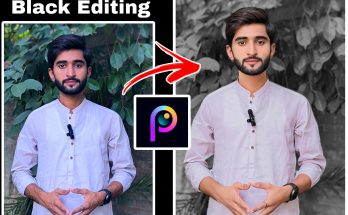In the realm of video editing, black effects, which span from subtle filters and overlays to fully monochrome scenes, have witnessed a dramatic surge in prominence. These captivating techniques possess the remarkable ability to transform narratives, evoke an enigmatic ambiance, and trigger complex emotional responses that often remain elusive with more vibrant hues. Over the past few years, the black effect has not only been embraced as an aesthetic choice but has also evolved into a formidable tool for guiding the viewer’s focus towards key elements, characters, or motifs. This article explores the rising prominence of this effect and outlines how it can be seamlessly woven into a filmmaker’s editing repertoire.
The Surge of Black Effects in the Editing World
What Fuels Its Popularity?
The increasing presence of black effects across cinematic productions, social media videos, and marketing campaigns can be attributed to their visually striking and arresting nature. The allure of these effects lies in their capacity to imbue content with a dramatic, somber, and often nostalgic undertone. As audiences seek richer, more immersive visual journeys, the black effect has established itself as a powerful device for both seasoned filmmakers and aspiring video editors alike.
Various Forms of Black Effects in Video Editing
Monochrome Filter
The timeless black-and-white filter remains a cornerstone of the craft, delivering a refined, cinematic aesthetic. It accentuates contrasts, heightens the play of light and shadow, and sharpens the emotional intensity of human expressions—all while stripping away the distractions of color. This technique gently draws the viewer deeper into the narrative, amplifying its emotional weight.
Black Overlay Effect
The black overlay involves superimposing a layer of shadow or darkness over parts of the frame, creating a visual guide that subtly directs the viewer’s focus. This technique proves particularly effective in suspense-driven genres such as horror, thrillers, or tense dramas, where it amplifies mood and intensifies tension, enhancing the sense of looming anticipation.
Benefits of Incorporating Black Effects
When used with intent, black effects yield a plethora of advantages. These effects often act as visual sharpeners, reducing color distractions and allowing the audience to hone in on textures, facial nuances, and essential objects. Furthermore, black effects contribute to shaping the emotional tone of a scene—whether invoking intrigue, sophistication, or melancholy. These characteristics make them a versatile and powerful storytelling tool, as they can easily set a creator’s work apart with a signature style.
Top Video Editing Software for Black Effects
Adobe Premiere Pro
As a dynamic editing powerhouse, Adobe Premiere Pro provides users with the tools needed to integrate black effects with remarkable precision. The software’s extensive range of features enables editors to fine-tune black-and-white levels, apply overlays, and customize each effect to achieve the desired visual depth.
Final Cut Pro
Known for its user-friendly interface, Final Cut Pro has garnered popularity for seamlessly incorporating black effects. With its efficient filters and straightforward color grading capabilities, the software offers simple adjustments to contrast and shadow, making it an excellent choice for producing high-contrast visuals.
DaVinci Resolve
Renowned for its color grading prowess, DaVinci Resolve stands out as an ideal tool for those who wish to add black effects with meticulous detail. Offering a comprehensive suite of professional-grade features, this software allows for an extraordinary level of refinement in manipulating light and shadow to craft the perfect monochromatic visuals.
A Step-by-Step Guide to Adding Black Effects
- Import Footage – Begin by uploading the video into your chosen editing software.
- Select Effect Type – Pick the appropriate black effect, whether it’s a black-and-white filter, an overlay, or contrast adjustments.
- Adjust Settings – Tweak the settings to balance the right contrast, brightness, and shadows.
- Add Overlay or Texture – Layer additional elements like grain or noise to enhance the effect.
- Preview and Export – Review the outcome, making sure it delivers the desired impact, and then export the final product.
Black Effects as a Narrative Tool
Black effects function as a potent storytelling device, especially when seeking to infuse emotional depth into a video. By minimizing color, these techniques draw the viewer’s attention toward the action, atmosphere, or emotional currents within the scene. For instance, during a tense sequence, black effects can intensify the suspense, while in documentary filmmaking, they lend a raw, authentic touch that draws the audience into the subject matter.
Black Effects in Social Media Content
Popular Platforms Embracing Black Effects
Social platforms such as Instagram, TikTok, and YouTube have championed the use of black effects with filters and emerging video trends. TikTok, in particular, has embraced dark overlays and monochromatic visuals, which creators use to evoke themes of nostalgia, mystery, and sophistication.
Pro Tips for Mastering Black Effect Videos
- Opt for High-Quality Footage: Ensure your base footage is of high resolution to avoid pixelation or graininess when applying the effect.
- Balance Shadows and Highlights: Strive for a delicate equilibrium between light and dark to avoid overly harsh visuals.
- Focus on Key Moments: Apply black effects sparingly, selecting moments that elevate the emotional depth or significance of the scene.
- Experiment with Textures: Experiment with elements like scratches or dust, which can imbue the video with an antique or cinematic aesthetic.
Noteworthy Examples of Black Effects in Film and Media
Black effects have long been synonymous with creating distinctive atmospheres in cinema. For example, the legendary Alfred Hitchcock frequently employed black-and-white imagery to heighten suspense in his films. In contemporary works like The Lighthouse or Billie Eilish’s music videos, black effects serve to elicit powerful emotional responses and craft an unforgettable visual identity.
Common Pitfalls to Avoid with Black Effects
- Excessive Use: Overuse of black effects can create a monotonous viewing experience, overwhelming the audience.
- Mismatch with Scene Tone: The effect should align with the mood or theme of the scene; its indiscriminate application may detract from the narrative’s impact.
- Neglecting Quality Control: Always verify the post-effect quality to prevent visual degradation, as excessive darkening may lead to pixelation.
Versatility of Black Effects Across Video Formats
Music Videos
Black effects are frequently featured in music videos, particularly within genres such as hip-hop, pop, and rock. These effects enhance the emotional tone of the music, complementing the artist’s vision and amplifying the aesthetic.
Advertisements
In advertising, black effects are often used to project an image of luxury and exclusivity. They are particularly effective in promoting high-end products such as fashion, jewelry, and perfumes, imbuing the brand with an air of sophistication and allure.
Short Films
Within the realm of short films, black effects are especially prevalent in genres like horror and drama. They allow for the creation of a potent atmosphere, heightening emotional resonance and establishing tone, often reducing reliance on dialogue.
Best Mobile Apps for Black Effect Video Editing
For those on the move, mobile apps like InShot, KineMaster, and Adobe Premiere Rush offer a convenient way to apply black effects on the go. These apps provide various filters and editing tools, enabling users to craft professional-quality black effects without the need for desktop software.
Advanced Techniques for Black Effect Editing
For experienced editors, techniques such as blending modes, composite layers, and masking allow for even more refined manipulation of black effects. These methods enable editors to apply effects to specific sections of the frame, keeping certain elements in color while selectively desaturating others, creating a more dynamic and nuanced visual experience.
Conclusion
The integration of black effects in video editing opens a vast array of creative possibilities. Whether the goal is to build suspense, craft an unforgettable aesthetic, or convey a specific emotional tone, mastering these techniques allows editors to elevate their work to new heights. By experimenting with different tools, settings, and approaches, creators—both novice and seasoned—can produce compelling, visually striking content that resonates deeply with audiences. Through thoughtful execution, the power of black effects can transform a standard video into a truly remarkable one.
🎨 Love Photo Editing & AI Prompts?
Join our WhatsApp Channel to get the latest AI art prompts, editing tips, and exclusive resources!
👉 Join Now on WhatsApp



